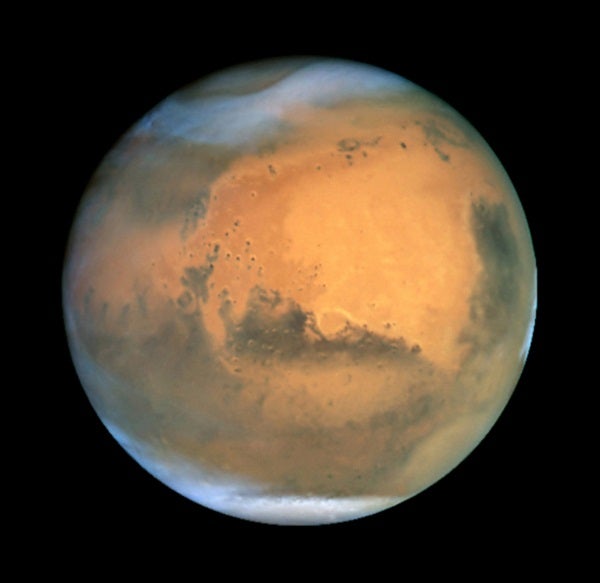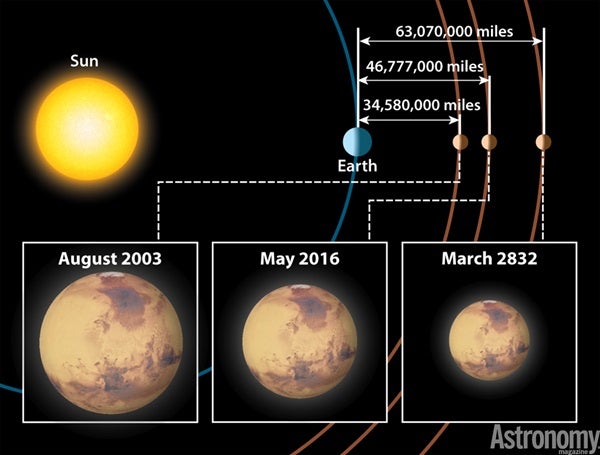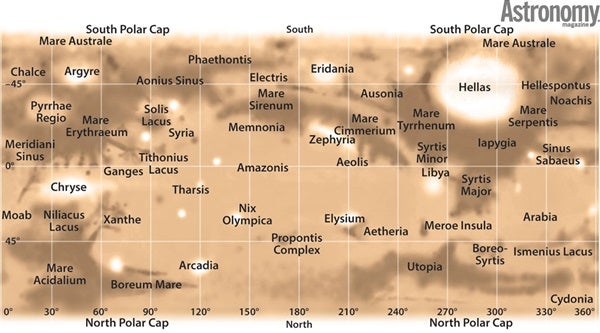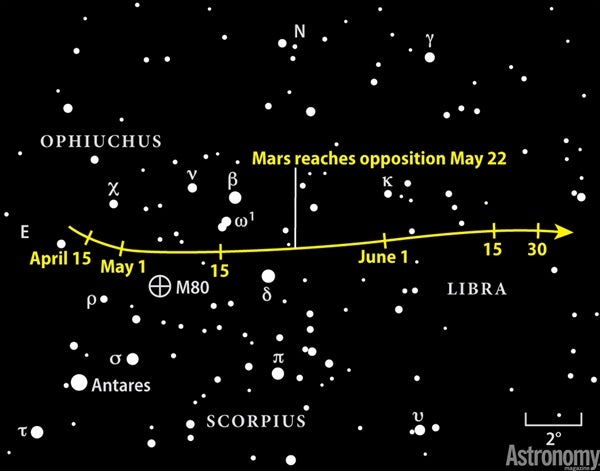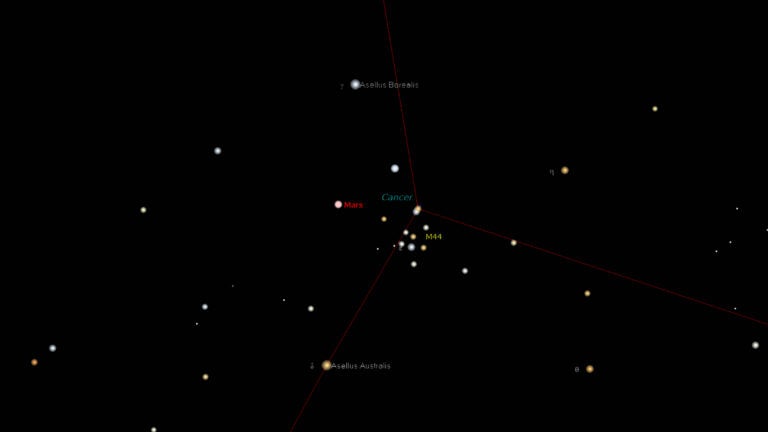In the 1980s, a friend described observing Mars to me as “two long years of waiting for four to six weeks of panicked activity,” referring to Mars’ closest approach to Earth every 26 months. How true that statement was. But equipment is better now, so you don’t have to wait for the Red Planet to reach its largest size. If you have a 4-inch or larger scope and steady air above your observing site, you will see details on the martian disk. Start looking on the next clear night, and then every clear night after that. Because before you know it, this apparition of Mars will be history.
The numbers game
Amateur astronomers concentrate on observing Mars near its opposition. At this point in its orbit, Mars rises in the east as the Sun sets, making it visible in our sky all night. Some oppositions are more favorable than others because Mars lies closer to the Sun (and therefore to Earth). The 2016 martian opposition occurs at 11h17m UT (7:17 a.m. EDT) May 22.
The point of closest approach between Mars and Earth occurs eight days after opposition. At 21h34m UT (5:34 p.m. EDT) May 30, Mars lies 0.5 astronomical unit, or 46,777,000 miles (75,280,000km), from Earth. Closest approach marks the date when Mars’ diameter is greatest — 18.6″. This size is nearly 7″ smaller than when the Red Planet was at its closest point in recent history in August 2003, but it’s larger than it has been at any opposition since 2005.
The date of opposition also is when Mars appears brightest. This year, the planet shines at magnitude –2.1. In lay terms, Mars will dazzle us at some 20 times brighter than the nearby 1st-magnitude red supergiant Antares (Alpha [α] Scorpii). Curiously, the word Antares means “rival of Mars.” This refers to the similar color of the two objects, but only at certain times. When the planet is as brilliant as it will be this month, its hue is closer to orange-white than red.
Now for the bad news: Mars lies in the constellation Scorpius for its opposition and Libra for its closest approach. The planet crosses into the Scales on May 28 and stays there until it once again enters Scorpius on August 2.
The southerly locations of these two star patterns mean Mars won’t appear high in the sky for Northern Hemisphere observers. In fact, the planet’s declination at opposition will be –21°39′. For an observer at 40° north latitude, Mars will climb a scant 28° above the southern horizon. (Because celestial objects rise in the east and set in the west, they reach their highest point when they’re directly south.)
This low altitude is significant because the thickest, most distorting part of Earth’s atmosphere lies near the horizon. As you look at objects higher in the sky, less atmosphere lies between your eyes and the object. So, having two-thirds of the sky above the planet will make observing Mars this year an adventure for Northern Hemisphere observers.
Have a look
Beginners often ask which telescope is best for observing Mars. The answer is simple: the biggest. The larger your scope, the more detail it can resolve in a celestial object. But a good view of the Red Planet depends more on the quality of your sky than on the size of your scope.
One thing working against us is that Mars is a small object — nowhere as big as most star clusters, nebulae, or galaxies — so it requires high magnification for details to be visible. This means if the air above your observing site is unsteady, you won’t be able to use high power.
On the positive side, Mars is bright this year. That means light pollution is irrelevant. In fact, some ambient light actually is welcome when you observe the Red Planet. A white light off to your side (not directly in your field of view) and lighting up your surroundings will cause your daytime vision — which is superior to your night vision in both resolution and color sensitivity — to kick in.
Because of the Red Planet’s smaller size, thin atmosphere, and lack of erosion, surface features there tend to be more pronounced than Earth’s.
With a 4-inch telescope, you can observe the larger albedo features. These include Syrtis Major, the Hellas basin, Solis Lacus, and the North Polar Ice Cap, which will be tilted 12° toward Earth. Don’t confuse Hellas with the polar cap. Hellas is a round, bright feature — an impact basin with lots of light-colored dust and sometimes fog or clouds. When seen near the limb (the planet’s edge), Hellas can look like a polar cap. In all cases, compare your view with the map above.
Through a 6-inch or larger scope, you can observe several types of clouds in Mars’ atmosphere. One type is discrete clouds, which stick to one area as the planet rotates. Most discrete clouds are in Mars’ northern hemisphere during spring and summer. A blue filter works best on them.
Orographic clouds are discrete clouds made of water ice. They form when wind passes over the peaks of martian mountains and volcanoes. High-altitude orographic clouds look best through a blue or violet filter. A green filter works best on low-altitude orographic clouds.
Finally, you can observe morning and evening clouds. These bright patches of fog form at sunrise or sunset. Don’t confuse such a sighting with ground frost. Morning clouds disappear in a few hours. Frost may last all day. Evening clouds are generally larger, and there are more of them. They grow as the martian night approaches.
Head outside now
The best time to observe Mars is tonight. Take advantage of the planet’s size and brightness, and don’t worry that it’s so low in the sky. Head out to a science center or observatory, contact your local astronomy club, or point your scope at the Red Planet, and take a good, long look.

